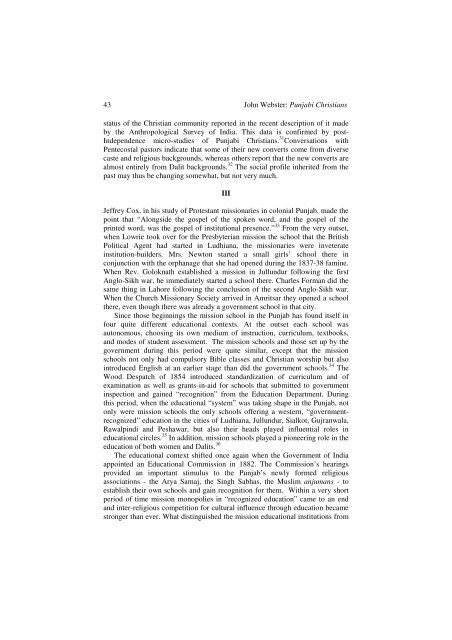Book Reviews - Global and International Studies Program ...
Book Reviews - Global and International Studies Program ...
Book Reviews - Global and International Studies Program ...
Create successful ePaper yourself
Turn your PDF publications into a flip-book with our unique Google optimized e-Paper software.
43 John Webster: Punjabi Christians<br />
status of the Christian community reported in the recent description of it made<br />
by the Anthropological Survey of India. This data is confirmed by post-<br />
Independence micro-studies of Punjabi Christians. 31 Conversations with<br />
Pentecostal pastors indicate that some of their new converts come from diverse<br />
caste <strong>and</strong> religious backgrounds, whereas others report that the new converts are<br />
almost entirely from Dalit backgrounds. 32 The social profile inherited from the<br />
past may thus be changing somewhat, but not very much.<br />
III<br />
Jeffrey Cox, in his study of Protestant missionaries in colonial Punjab, made the<br />
point that “Alongside the gospel of the spoken word, <strong>and</strong> the gospel of the<br />
printed word, was the gospel of institutional presence.” 33 From the very outset,<br />
when Lowrie took over for the Presbyterian mission the school that the British<br />
Political Agent had started in Ludhiana, the missionaries were inveterate<br />
institution-builders. Mrs. Newton started a small girls’ school there in<br />
conjunction with the orphanage that she had opened during the 1837-38 famine.<br />
When Rev. Goloknath established a mission in Jullundur following the first<br />
Anglo-Sikh war, he immediately started a school there. Charles Forman did the<br />
same thing in Lahore following the conclusion of the second Anglo-Sikh war.<br />
When the Church Missionary Society arrived in Amritsar they opened a school<br />
there, even though there was already a government school in that city.<br />
Since those beginnings the mission school in the Punjab has found itself in<br />
four quite different educational contexts. At the outset each school was<br />
autonomous, choosing its own medium of instruction, curriculum, textbooks,<br />
<strong>and</strong> modes of student assessment. The mission schools <strong>and</strong> those set up by the<br />
government during this period were quite similar, except that the mission<br />
schools not only had compulsory Bible classes <strong>and</strong> Christian worship but also<br />
introduced English at an earlier stage than did the government schools. 34 The<br />
Wood Despatch of 1854 introduced st<strong>and</strong>ardization of curriculum <strong>and</strong> of<br />
examination as well as grants-in-aid for schools that submitted to government<br />
inspection <strong>and</strong> gained “recognition” from the Education Department. During<br />
this period, when the educational “system” was taking shape in the Punjab, not<br />
only were mission schools the only schools offering a western, “governmentrecognized”<br />
education in the cities of Ludhiana, Jullundur, Sialkot, Gujranwala,<br />
Rawalpindi <strong>and</strong> Peshawar, but also their heads played influential roles in<br />
educational circles. 35 In addition, mission schools played a pioneering role in the<br />
education of both women <strong>and</strong> Dalits. 36<br />
The educational context shifted once again when the Government of India<br />
appointed an Educational Commission in 1882. The Commission’s hearings<br />
provided an important stimulus to the Punjab’s newly formed religious<br />
associations - the Arya Samaj, the Singh Sabhas, the Muslim anjumans - to<br />
establish their own schools <strong>and</strong> gain recognition for them. Within a very short<br />
period of time mission monopolies in “recognized education” came to an end<br />
<strong>and</strong> inter-religious competition for cultural influence through education became<br />
stronger than ever. What distinguished the mission educational institutions from













![Download entire Journal volume [PDF] - Global and International ...](https://img.yumpu.com/21518781/1/190x245/download-entire-journal-volume-pdf-global-and-international-.jpg?quality=85)



